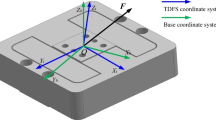Abstract
Besides finding the target values of every component of an assembled product, it is also necessary to find the best compromise between the quality product cost and the quality assembled cost. To this end, Genichi Taguchi and Don Clausing suggested using Taguchi’s lost function to evaluate these quality costs. Based on this function, Pillet suggested a new approach, called “inertial tolerancing”. This approach is a new language between the designer and the process engineering department. It allows a link to be made between the quality product cost and the quality assembled cost and then to use statistical tolerancing in the assembled design. This paper presents the efficiency of the use of this approach during the design phase for assembling two components and also its efficiency during the production phase for the monitoring with an inertia control chart. In order to illustrate this, these new approaches are used in industrial cases and compared to the traditional approach (tolerancing and monitoring) to underline the economic benefit which can be obtained using the inertial approach.







Similar content being viewed by others
References
Bender, A.: \(6\times 2.5 =9.\) Benderizing tolerances—a simple practical probability method of handling tolerances for limits-stack-ups. In: Graphic Science, pp. 17–21 (1962)
Acton, F.S., Olds, E.G.: Tolerances-additive or pythagorean? Ind. Qual. Control. 5(3):6–12 (1948)
Gilson, J.: A new approach to engineering tolerances, Chapter 3, pp. 42–48. The machinery publishing CO. LTD, London (1951)
Pillet, M.: Inertial tolerancing. Total Qual. Manag. 16(3), 202–209 (2004)
Shewhart, W.A.: Quality control charts. Bell Syst. Tech. J. 5, 593–602 (1926)
Roberts, S.W.: Control charts based on geometric moving averages. Technometrics 32(2), 163–171 (1959)
Pages, E.S.: Continuous inspection schemes. Biometrika 41, 100–115 (1954)
Taguchi, G.: System of Experimental Design, Engineering Methods to Optimize Quality and Minimize Costs, vol. 1, 2. American Supplier Institute Inc, Livonia (1987)
Van-Hoecke, A.: Modeling and Competencies Electromechanics Profession: Statistical Tolerancing. Schneider Electrics Internal Guideline (2006)
Adragna, P.A.: Tolérancement des systèmes assemblés, une approche par le tolérancement inertiel et modal, Thesis of the University of Savoy (2007)
Graves, S.: Tolerance analysis formula tailored to your organisation. J. Qual. Technol. 33(3), 293–303 (2001)
Brandt, D.A.: How not to use statistical dimensioning machine design, pp. 111–113 (1973)
Graves, S.: How to reduce costs using a tolerance analysis formula tailored to your organization. CQPI report, no. 157 (1997)
Graves, s, Bisgaard, S.: Five ways statistical tolerancing can fail, and what to do about them. Qual. Eng. 13(1), 73–82 (2000)
Scholz F.: Tolerance Stack Analysis Methods. Research and Technology, Boeing Information & Support Services, Boeing (1995)
Anselmetti, B.: Manuel de tolérancement, vol. 3: cotation fonctionnelle tridimensionnelle et statistique, edition Lavoisier (2008)
Quesenberry, C.P.: The effect of sample size on estimated limits for X-bar and X control charts. J. Qual. Technol. 25(4), 237–247 (1993)
Pillet, M., Adragna, P.A., Ozouf, V., Guerra, A.S.: Pilotage par carte de contrôle dans le cas du tolérancement inertiel, Qualita 2007, TANGER - Maroc (2007)
Minte-Te, C., Smiley, W.C.: On 2-D control charts. Int. J. Qual. Technol. Quant. Manag. 5(3), 243–261 (2008)
Montgomery, D.C.: Introduction to Statistical Quality Control, 3rd edn. Wiley, New York (1996)
Western Electric: Statistical Quality Control Handbook. Western Electric Corporation, Indianapolis (1956)
Juran, J.M., et al.: Juran’s Quality Handbook. McGraw-Hill, New York (1988)
Nelson, L.S.: Interpreting Shewhart control charts. J. Qual. Technol. 17(2), 114–116 (1985)
Nelson, L.S.: The Shewhart control charts-test for special causes. J. Qual. Technol. 16(4), 237–239 (1984)
Davis, R.B., et al.: Performance of the control charts trend rule under linear shift. J. Qual. Technol. 20, 260–262 (1988)
Divoky, J.J., et al.: Detecting process drift with combinations of trend and zonal supplementary runs rules. Int. J. Qual. Reliab. Manag. 12(2), 60–71 (1995)
Zhang, S., et al.: Designs of control charts with supplementary runs rules. Comput. Ind. Eng. 49, 76–97 (2005)
Chen, Y.-K., Liao, H.-C.: Multi-criteria design of an Xb control chart. Comput. Ind. Eng. 46, 877–891 (2004)
Gayri, S.K., Shankar, C.: Feature based recognition of control chart patterns: a generalized approach. Comput. Ind. Eng. 51, 726–742 (2006)
Harrington, J.H.: Pietri. René, Le coût de la non qualité, Eyrolles Edition (1990)
Thomas, Pyzdek: The Six Sigma Handbook: The Complete Guide for Greenbelts, Blackbelts, and Managers at All Levels, Revised and Expanded Edition (Hardcover) (2006)
Shewhart, W.A., Deming, W.E.: Statistical Method from the Viewpoint of Quality Control Mineola. Dover Publications, Inc., New York (1986)
Taguchi, G., Clausing, D.: Robust quality. Harv. Bus. Rev. 65–75 (1990)
Author information
Authors and Affiliations
Corresponding author
Rights and permissions
About this article
Cite this article
Denimal, D., Pillet, M. & Sergent, A. Inertial control chart “industrial application and feedback”. Int J Interact Des Manuf 8, 255–264 (2014). https://doi.org/10.1007/s12008-014-0225-4
Received:
Accepted:
Published:
Issue Date:
DOI: https://doi.org/10.1007/s12008-014-0225-4




